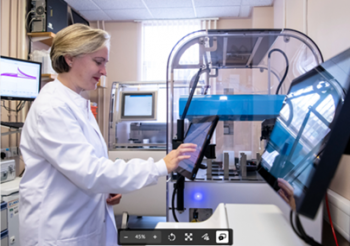Ion channel physiology and pharmacology
Learn about the state-of-the-art Ion Channel Electrophysiology at Sussex
What are ion channels?
Ion channels are specialised proteins that selectively control the flow of ions from one side of a lipid membrane to the other. They mediate fast bioelectric signals on a millisecond timescale, underlying processes such as nerve conduction, muscle contraction and secretion that are vital to normal human physiology. Their conductance pathways or ‘pores’ are opened or closed in a variety of ways dependent on the function they perform, with different ion channel families responding to ligand binding, changes in voltage, movement or stretch of the membrane, detection of heat or cold, or simply exhibiting time-dependency.
Ion channels in drug discovery
The ability to record ionic conduction across a cell membrane on a millisecond timescale has advanced our understanding of fast physiological responses and enabled us to identify and study the key ion channel components that facilitate these responses. With over 400 ion channel genes encoded in the human genome, it has also opened the field of drug discovery to a multitude of ‘channelopathies’, including cystic fibrosis, neuromuscular disorders, kidney diseases and arrhythmias. However, this information-rich recording technique has historically been time-consuming, costly and the rate-limiting step in pursuing ion channels as drug targets.

At the Sussex Drug Discovery Centre, we are proud to be the only UK academic establishment with a suite of industry-standard planar patch-clamp platforms, which is being run in partnership with Sophion Biosciences. Complementary to our use of conventional single-cell and single-channel electrophysiology and Ussings chamber recording of ionic conductance across tissues, planar patch-clamp enables us to scale-up the generation of high-quality data quickly, developing our understanding and informing our design of compounds that can stimulate, modulate or inhibit the function of both healthy and diseased ionic conductance pathways.